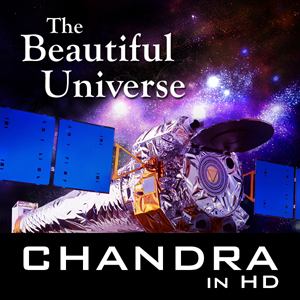Episodes
Astronomers have discovered one of the most powerful eruptions from a black hole ever recorded. This mega-explosion may help explain the formation of a striking pattern of star clusters around two massive galaxies, resembling "beads on a string."
Published 02/21/24
Published 02/21/24
The supermassive black hole in the center of the Milky Way is spinning so quickly it is warping the spacetime surrounding it into a shape that looks like an American football.
Published 02/08/24
For the first time scientists have combined the powers of NASA's Chandra & Webb Space Telescopes to study the famous supernova remnant Cassiopeia A, helping to solve the mystery behind the remnant's "Green Monster".
Published 01/18/24
These four images represent a sample of galaxy clusters that are part of the largest and most complete study to learn what triggers stars to form in the universe's biggest galaxies.
Published 01/18/24
A group of dead stars known as "spider pulsars" are obliterating companion stars within their reach.
Published 11/30/23
Astronomers found the most distant black hole ever detected in X-rays using the Chandra and Webb telescopes.
Published 11/06/23
Chandra's data of MSH 15-52 have been combined with data from NASA's newest X-ray telescope, IXPE to unveil the magnetic field "bones" of this remarkable structure.
Published 10/30/23
Using snapshots taken over 20 years with NASA's Chandra X-ray Observatory, astronomers have learned important new details about an eruption from Eta Carinae witnessed on Earth in the mid-19th century.
Published 09/26/23
A new collection of stunning images highlights data from NASA's Chandra X-ray Observatory and other telescopes.
Published 09/13/23
Astronomers using NASA's Chandra, ESA's XMM-Newton, and other telescopes have determined that a giant black hole has destroyed a large star and strewn its contents into space.
Published 08/22/23
Astronomers have discovered the most distant galaxy cluster with an important quality — providing insight into how these gigantic structures formed and why the universe looks like it does in the present day.
Published 07/20/23
Three new 'sonifications' of NASA data have been released: R Aquarii, Stephan’s Quintet, and M10.
Published 06/20/23
The NGC 4839 group of galaxies is plunging into the Coma galaxy cluster and leaving behind an extraordinary tail of superheated gas.
Published 06/06/23
Four composite images deliver dazzling views from NASA's Chandra X-ray Observatory and James Webb Space Telescope of two galaxies, a nebula, and a star cluster.
Published 05/23/23
With a single letter seemingly etched in the X-ray glow around it, a giant black hole at the center of a massive elliptical galaxy is making a mark on its surroundings.
Published 05/04/23
Astronomers have identified a new threat to life on planets like Earth: a phase during which intense X-rays from exploded stars can affect planets over 100 light-years away.
Published 04/20/23
Data from Chandra show the effects of powerful winds launched from the center of a nearby galaxy.
Published 03/29/23
A distant – and lonely – galaxy appears to have pulled in and assimilated all of its former companion galaxies.
Published 03/08/23
A new study using NASA's Chandra X-ray Observatory has tracked two pairs of supermassive black holes in dwarf galaxies on collision courses.
Published 02/22/23
Astronomers have captured a spectacular, ongoing collision between at least three galaxy clusters. Data from Chandra, XMM-Newton, and a trio of radio telescopes are helping astronomers sort out what is happening in this jumbled scene.
Published 01/30/23
A new survey using NASA's Chandra X-ray Observatory has uncovered hundreds of previously "hidden" black holes.
Published 01/11/23
A new study provides insight into how X-rays from stars like our Sun, but billions of years younger, could partially or completely evaporate the atmospheres of planets orbiting them.
Published 12/15/22
A study of RCW 36 shows that stars in a cluster can limit how many new stars form when the biggest and brightest members expel most of the gas from the system, thus drastically slowing down star birth.
Published 11/29/22
Planets can force their host stars to act younger than their age, according to a new study of multiple systems using NASA's Chandra X-ray Observatory.
Published 11/02/22


